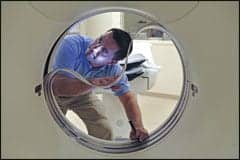A Tiny—Yet Mighty—Team
Last year, Ind.-based Columbus Regional Health celebrated 100 years in operation. On the heels of this milestone, Brian Morlok, manager, facilities and clinical engineering, sits down with 24×7 Magazine to discuss how Columbus Regional Hospital’s HTM department is integral to the hospital’s success—and longevity—and how the five-person-strong team’s diverse skill set is a boon to operations.
24×7 Magazine: Can you please tell us a little bit about your team and the workload you handle?
Brian Morlok: Our four technicians perform preventive maintenance, corrective maintenance, calibrations, installations, and project management/implementation for about 6,000 devices. We have also started bringing on all of our systems outside physician practices and ambulatory care centers.
24×7: How has your department evolved over the past few years?
Morlok: Over the past few years, our department has tried to strike a balance between the skill set we are trying to develop internally and what we want to keep under vendor contract. We’re also trying to balance what size we need to be to take on an increased workload. In doing so, we have continued training for the ever-evolving medical field, as well as our expanding scope as the hospital system grows.
Our department has also merged with facilities maintenance and has had several new hires. Specifically, our previous manager retired and a few new grads moved on to achieve their career ambitions. Fortunately, we now seem to have a stable crew with long-term commitments to the area and the hospital.
24×7: What would your HTM team say are the biggest challenges they face on a daily basis?
Morlok: The increased connectivity of machines and the reliance on IT to make things work effectively for the clinical staff is definitely a challenge. There is also the struggle of finding a way to manage downtime or get access to equipment in periods of high hospital census. Plus, keeping your equipment on schedule can be hard when the nursing staff hides their favorite devices in a supply closet or when the hospital beds are constantly in use.
24×7: HTM professionals are often the unsung heroes of the hospital. Can you please discuss a time when your team ‘saved the day’ for another department or positively affected patient care?
Morlok: By installing new medical equipment, we ensure our patients receive the most current technology designed for their treatment; by calibrating it, we ensure that the equipment used for their diagnosis is the most accurate. And by repairing medical equipment, we ensure that the equipment used for their rehabilitation is without faults.
Finally, by maintaining medical equipment, we ensure the safety of every patient, employee, and visitor who may come in contact with it. Our work as HTM professionals plays a key role in the treatment, diagnosis, rehabilitation, and safety of every person who we help at Columbus Regional Hospital.
While putting our new hybrid OR into operation—a project we weren’t included in until a week before the go-live date—we were able to sync our bedside monitors and anesthesia machines to the EMR, work with IT to program network jacks, and install and set up the new equipment for the room. We worked as a team to stay on track and meet the deadline of having the equipment up and ready for the go-live date and safe for the first patient use in the new room.
While setting up for surgery the next day, some equipment was dropped and [subsequently] broke on a dental cart used for pediatric dental reconstructions. However, one of the members of our team was able to stay late and repair the unit so that no cases had to be cancelled. Since the pediatric dental specialist only has limited OR time, any downtime at all was going to be a real struggle for some of the children needing surgery and require lots of rescheduling. Being able to prevent patient downtime is an important part of our role in keeping patient care at its best.
24×7: Imaging devices are some of the most fragile—and costly—equipment HTM professionals count among their inventories. What types of medical imaging equipment does your team maintain, and/or how big of a role does maintaining imaging equipment play in your day-to-day workload?
Morlok: The department takes care of three cath labs, three CT scanners, one CT PET scanner, one MRI machine, two portable x-ray units, five general x-ray rooms, an OR hybrid room, a Lithotripter unit, two nuclear medicine rooms, two linear accelerators, and a variety of C-arms and ultrasound machines. With these units, we are transitioning from primarily vendor-based care to more internal care. Specifically, we get a variety of calls on connectivity and image transfer, as well as damage to handheld units.
24×7: Is there anything else you would like to share about your team and what sets them apart from others with 24×7 Magazine’s readers?
Morlok: We are an outgoing, headstrong, and exceptional group of four [biomeds], who have diverse backgrounds and don’t break under extreme situations. Our diverse backgrounds are represented in our training and experience levels, which range from an Army-trained biomed to college graduates with years of biomed experience to new HTM techs. We even have a tech with an MBA degree—something that’s very useful since a lot of our day to day involves business or contract negotiations, as well as department management issues.
With backgrounds in being in-house employees and OEM field-service reps, we are covering not only just the main hospital campus, but various off-site buildings and practices as well. We are also transitioning to take care of a lot more equipment in-house, instead of having service contracts, all the while maintaining and improving our patients’ satisfaction and streamlining department workflow.




